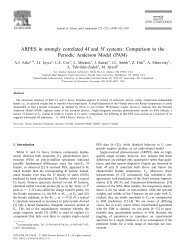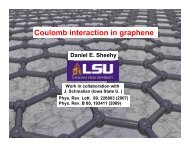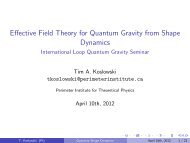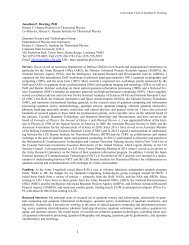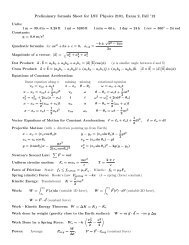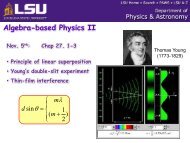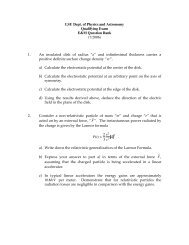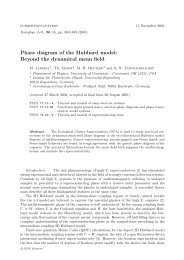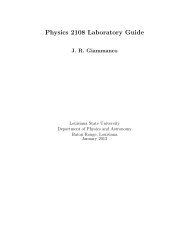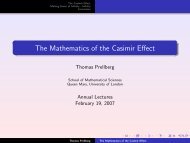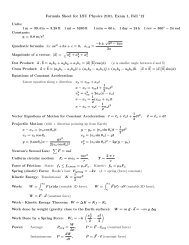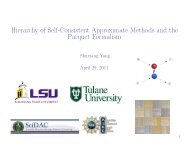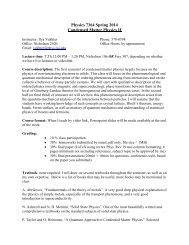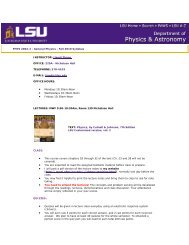Phase Diagram of the Two-Channel Kondo Lattice - APS Link ...
Phase Diagram of the Two-Channel Kondo Lattice - APS Link ...
Phase Diagram of the Two-Channel Kondo Lattice - APS Link ...
You also want an ePaper? Increase the reach of your titles
YUMPU automatically turns print PDFs into web optimized ePapers that Google loves.
VOLUME 78, NUMBER 10 PHYSICAL REVIEW LETTERS 10MARCH 1997<br />
first even at half-filling (<strong>the</strong> minus sign problem precluded<br />
a systematic study for <strong>the</strong>se values <strong>of</strong> J so <strong>the</strong>y are not<br />
presented in Fig. 4). We also found that T CJT 0 ,<br />
with CJ 0.5 and weakly dependent on J. In contrast,<br />
T N appears to depend upon both J and T 0 .<br />
Speculation and Interpretation.—We <strong>of</strong>fer two compatible<br />
interpretations <strong>of</strong> <strong>the</strong> result T 0.5T 0 . First, T 0 is<br />
<strong>the</strong> local dynamic energy scale, and thus this result underscores<br />
<strong>the</strong> local origin <strong>of</strong> <strong>the</strong> pairing. Second, T 0.5T 0<br />
is also <strong>the</strong> temperature at which <strong>the</strong> slope <strong>of</strong> <strong>the</strong> real part<br />
<strong>of</strong> <strong>the</strong> self-energy becomes one [11], so that <strong>the</strong> quasiparticle<br />
renormalization factor diverges. This result suggests<br />
that, when <strong>the</strong> system cannot form a Fermi liquid due to<br />
a large residual scattering rate (with concomitant residual<br />
entropy), it forms a superconducting state to quench <strong>the</strong><br />
entropy. The antiferromagnetic transition temperature, on<br />
<strong>the</strong> o<strong>the</strong>r hand, depends upon both J (through <strong>the</strong> intersite<br />
exchange) and T 0 (through moment screening and superexchange).<br />
As noted above, we cannot determine whe<strong>the</strong>r<br />
<strong>the</strong>se states coexist without a detailed exploration within<br />
<strong>the</strong> ordered phases. At half-filling, where <strong>the</strong> antiferromagnetism<br />
produces an insulating phase, clearly <strong>the</strong> superconductivity<br />
will be suppressed for J # 0.75.<br />
Our results <strong>of</strong>fer a number <strong>of</strong> routes to be explored for<br />
explaining <strong>the</strong> complex superconducting phase diagrams<br />
<strong>of</strong> UPt 3 and U 12x Th x Be 13 : (1) Competition between<br />
phases with a multipoint irreducible star: As mentioned<br />
above, for Y s , 0 in finite d, q fi 0 pairs are favored,<br />
quite likely at <strong>the</strong> Brillouin zone corner for such a bipartite<br />
lattice. For lattices with frustration, such as hexagonal<br />
UPt 3 and fcc UBe 13 , multipoint irreducible stars may<br />
be needed to describe staggered order parameters which<br />
can <strong>the</strong>n have multiple phases [19]. (2) Competition between<br />
different q values: As noted above, T , <strong>the</strong> lower<br />
bound for <strong>the</strong> first order superconducting transition temperature,<br />
is independent <strong>of</strong> q in our calculations. Thus<br />
multiple phases may thus correspond to superconducting<br />
transitions with different q values. (3) Possible instability<br />
<strong>of</strong> spin-tripletchannel-triplet pairing: At yet lower temperatures<br />
than those identified in Fig. 4, we observe a sign<br />
change in <strong>the</strong> pair-field susceptibility associated with spin<br />
triplet-channel triplet odd-frequency pairing. Hence it is<br />
possible that <strong>the</strong> competition between this triplet-triplet<br />
and <strong>the</strong> singlet-singlet odd-frequency pairing may explain<br />
<strong>the</strong> complex phase diagrams.<br />
In conclusion, we note that this superconducting transition<br />
can agree with experiment only if it is weakly first<br />
order; this is plausible given <strong>the</strong> rapid change in free energy<br />
curvature at <strong>the</strong> order parameter origin. Detailed investigations<br />
in <strong>the</strong> ordered phase will resolve this issue,<br />
and whe<strong>the</strong>r any <strong>of</strong> <strong>the</strong> above scenarios can describe <strong>the</strong><br />
complex phase diagrams <strong>of</strong> UPt 3 and U 12x Th x Be 13 .<br />
We would like to acknowledge useful discussions<br />
with F. Anders, A. V. Balatsky, W. Chung, A. Georges,<br />
B. Goodman, D. Hess, H. R. Krishna-murthy, M. Ma, A. J.<br />
Millis, and W. Putikka. M. J. and H. P. would like to acknowledge<br />
<strong>the</strong> support <strong>of</strong> NSF Grants No. DMR-9406678<br />
and No. DMR-9357199. D. L. C. acknowledges <strong>the</strong> support<br />
<strong>of</strong> <strong>the</strong> NSF under Grant No. DMR-9420920. Computer<br />
support was provided by <strong>the</strong> Ohio Supercomputer<br />
Center.<br />
[1] Some good recent reviews are <strong>the</strong> following: N. Grewe<br />
and F. Steglich, Handbook on <strong>the</strong> Physics and Chemistry<br />
<strong>of</strong> Rare Earths, edited by K. A. Gschneidner, Jr.,<br />
and L. L. Eyring (Elsevier, Amsterdam, 1991), Vol. 14,<br />
p. 343; D. W. Hess, P. S. Riseborough, and J. L. Smith,<br />
Encyclopedia <strong>of</strong> Applied Physics, edited by G. L. Trigg<br />
(VCH Publishers Inc., New York, 1993), Vol. 7, p. 435;<br />
H. R. Ott, J. Low Temp. Phys. 95, 95 (1994).<br />
[2] J. A. Sauls, Adv. Phys. 43, 113–141 (1994).<br />
[3] V. L. Berezinski, JETP Lett. 20, 287 (1974); A. V.<br />
Balatsky and E. Abrahams, Phys. Rev. B 45, 13 125<br />
(1992); E. Abrahams et al., Phys. Rev. B 52, 1271 (1995).<br />
[4] P. Coleman, E. Miranda, and A. Tsvelik, Phys. Rev. Lett.<br />
70, 2960 (1993); P. Coleman, E. Miranda, and A. M.<br />
Tsvelik, Phys. Rev. B 49, 8955 (1994).<br />
[5] V. J. Emery and S. Kivelson, Phys. Rev. B 46, 10 812<br />
(1992).<br />
[6] A. W. W. Ludwig and I. Affleck, Nucl. Phys. B428, 545<br />
(1994).<br />
[7] Enhanced staggered odd-frequency pairing correlations<br />
exist in <strong>the</strong> one-dimensional <strong>Kondo</strong> lattice when left and<br />
right movers approximately decouple, rendering effectively<br />
a two-channel lattice; see O. Zachar, S. Kivelson,<br />
and V. Emery, Phys. Rev. Lett. 77, 1342 (1996).<br />
[8] D. L. Cox, Phys. Rev. Lett. 59, 1240 (1987); D. L. Cox,<br />
Physica (Amsterdam) 153C-155C, 1642 (1988); D. L.<br />
Cox, Physica (Amsterdam) 186B-188B, 312 (1993); D. L.<br />
Cox and M. B. Maple, Phys. Today 48, 32 (1995); D. L.<br />
Cox and M. Jarrell (unpublished).<br />
[9] F. Steglich et al., Physica (Amsterdam) 223B-224B, 1<br />
(1996).<br />
[10] This was noted much earlier in H. R. Ott, Prog. Low<br />
Temp. Phys. 6, 215 (1987).<br />
[11] M. Jarrell, H.-B. Pang, D. L. Cox, and K.-H. Luk, Phys.<br />
Rev. Lett. 77, 1612 (1996); M. Jarrell, H.-B. Pang, and<br />
D. L. Cox (unpublished); F. Anders, M. Jarrell, and D. L.<br />
Cox (unpublished).<br />
[12] P. Nozières and A. Blandin, J. Phys. (Paris) 41, 193<br />
(1980).<br />
[13] W. Metzner and D. Vollhardt, Phys. Rev. Lett. 62, 324<br />
(1989); see also E. Müller-Hartmann, Z. Phys. B 74, 507<br />
(1989).<br />
[14] Th. Pruschke, M. Jarrell, and J. K. Freericks, Adv. Phys.<br />
42, 187 (1995); A. Georges, G. Kotliar, W. Krauth, and<br />
M. Rozenberg, Rev. Mod. Phys. 68, 13 (1996).<br />
[15] R. M. Fye and J. E. Hirsch, Phys. Rev. B 38, 433 (1988).<br />
[16] K.-H. Luk, Mark Jarrell, and D. L. Cox, Phys. Rev. B 50,<br />
15 864 (1994).<br />
[17] M. Jarrell, Phys. Rev. B 51, 7429 (1995).<br />
[18] C. Owen and D. J. Scalapino, Physica (Amsterdam) 55,<br />
691 (1971).<br />
[19] R. Heid, Ya. B. Bazaliy, V. Martisovits, and D. L. Cox,<br />
Phys. Rev. Lett. 74, 2571 (1995).<br />
1999



